In dit artikel leg ik uit hoe je het maken van ondertitels voor je video's kunt versnellen met de automatische ondertitelgenerator. Alle informatie is gebaseerd op de verschillende tests die ik de afgelopen 3 jaar heb gedaan.
In 2016 deed ik mijn eerste ondertitelingsproject. Ik had toen net een video gemaakt voor een startup die een Kickstarter-campagne ging lanceren. Ik dacht dat het heel eenvoudig zou worden en dat het een kans was om een extra dienst te verkopen 🤑. Ik had geen idee waar ik aan begon... Aan het einde van dit project zei ik tegen mezelf:"Ik doe nooit meer aan ondertiteling".

Dat is alles wat ik vandaag doe. Wat deed me van gedachten veranderen? Het is simpel, het is me gelukt om mijn creatieworkflow te optimaliseren en mezelf uit te rusten met de juiste tools. Ik ben erin geslaagd om de tijd die nodig is om mijn ondertitels te maken door acht te delen.
In dit artikel leg ik uit hoe ik dat heb gedaan. Je hebt alle tips die je ook tijd besparen bij het maken van je ondertitels ⚡
Ik zal deze vragen beantwoorden:
- Werkt automatische ondertiteling?
- Kunnen we automatische ondertiteling van YouTube gebruiken?
- Wat is de beste oplossing voor online ondertiteling?
- Hoe ondertitel je een video automatisch in een vreemde taal?
Hier is het plan in detail:
1 – Hoe werkt automatische ondertiteling?
Als we het hebben over automatische ondertiteling, is het belangrijk om onderscheid te maken tussen twee behoeften. Er is "ondertiteling" in de originele taal van de video en er is "ondertiteling" in een vreemde taal. Je zult zien dat ondertiteling in een vreemde taal complexer is.

Automatische ondertiteling in de originele taal van de video
Gesloten ondertiteling in de oorspronkelijke taal maakt gebruik van wat spraakherkenning wordt genoemd. Dat wil zeggen, de oplossing haalt de audio uit de video en vervolgens kan het algoritme de gesproken woorden begrijpen en herschrijven.
In deze stap is het mogelijk om een woordenboek te hebben dat we zullen voeden met woorden zodat het algoritme zijn lexicale veld kan verbreden. Dit is bijvoorbeeld erg handig bij het gebruik van een bepaald of technisch jargon. We kunnen het ook een woordenlijst noemen.
Automatische ondertiteling in een vreemde taal met automatische vertaling
In het geval van automatische ondertiteling in een vreemde taal zal het algoritme eerst de ondertitels in de taal van de video maken en deze vervolgens op basis hiervan vertalen.
De kwaliteit van de machinevertaling hangt dus af van de kwaliteit van de ondertiteling in de taal van de video. Dus als u een kwaliteitsresultaat wilt, kunt u het beste de originele bijschriften controleren voordat u ze automatisch vertaalt. Elke correctie die niet op de originele onderschriften wordt aangebracht, moet op alle vreemde talen worden aangebracht. Als je maar één taal hebt, maakt het niet veel uit, maar als je 15 talen hebt, scheelt dat aanzienlijk in je werktijd.
Hoe automatische ondertiteling werkt?
Hoe gaat het aan de kant van het algoritme? Of het nu gaat om spraakherkenning of automatische vertaling, de logica is vrijwel gelijk. Het idee vandaag is niet om in te gaan op de technische details, maar om de logica erachter te begrijpen.

Het gegenereerde resultaat hangt af van wat een model wordt genoemd. Het is dit model dat de logica bevat die wordt gebruikt om audio in tekst om te zetten. Dit model wordt aangevuld met een set data waarmee we het gaan voeden. Bijvoorbeeld door het video's te geven en vervolgens het door het model gegenereerde resultaat te corrigeren. Het model zal zijn wijzigingen opslaan en er rekening mee houden wanneer het opnieuw in een vergelijkbare situatie terechtkomt.
Als u een veel technischere presentatie wilt, nodig ik u uit om dit artikel te lezen, dat in het Engels is en gaat over machine learning en deep learning.
Maak automatische ondertitels.
Begin gratis2 – Welke oplossing om ondertitels automatisch te genereren?
Er zijn verschillende oplossingen op de markt. De ideale oplossing hangt af van de behoefte die u heeft en van uw technische vaardigheden of die van uw team.
U kunt kiezen uit deze drie hoofdfamilies van oplossingen:
- externe API's (voor technische teams)
- maak je eigen neurale model (het meest complexe)
- gebruik een online ondertiteleditor (de eenvoudigste)
Externe API's voor spraakherkenning en machinevertaling, als u over technische vaardigheden beschikt.
Opgemerkt moet worden dat deze oplossing technische vaardigheden vereist.
API voor spraakherkenning
Het principe is om verbinding te maken met een externe dienst, de video of audio ernaar te sturen en het zal ons direct een bestand sturen met alle woorden met hun tijdcodes. Vervolgens moeten we de ondertitels uit dit bestand opbouwen.
De beste spraakherkennings-API's
Zoals we eerder hebben gezien, heeft elke API-provider een ander model. En het model zal een min of meer relevant resultaat geven, afhankelijk van de taal die u gaat gebruiken. Google kan u bijvoorbeeld het beste resultaat geven voor een video in het Engels, maar dat hoeft niet het geval te zijn voor een video in het Spaans. Om het beste resultaat te krijgen, moet u de verschillende API's testen en kijken welke de beste kwaliteit geeft, afhankelijk van de video's die u moet ondertitelen.
Hier is de lijst met de krachtigste API's die momenteel worden gebruikt in spraakherkenning:
- Google Spraak-naar-tekst
- AWS
- Azuurblauw
- IBM
- Speechmatica
API voor machinevertaling
Voor machinevertaling API's sturen we de originele tekst, de originele taal en de gewenste vertaaltaal. De API stuurt ons dan een tekst die overeenkomt met de machinevertaling die door het systeem is gegenereerd.
De beste API's voor machinevertaling
Net als spraakherkennings-API's is het moeilijk te zeggen dat dit u het beste resultaat zal opleveren. Het hangt af van de brontaal en de vertaaltaal die u gaat gebruiken. Google is een toonaangevende speler op het gebied van machinevertaling, met meer dan 110 talen. Maar het is verre van de beste presteerder in al deze talen. De kleine nieuwe Deepl is buitengewoon krachtig in een tiental talen, waaronder Engels, Spaans, Italiaans, Duits...
- Google Translate-API
- Microsoft vertaal-API
- API vertalen
- API voor tekstvertaling
- SYSTRAN.io Vertaal-API
- MyMemory Translation-API
- Deepl-API
- Mijn Translator Pro API
- Linguatools Translate-API
- Yandex Translate-API
- IBM Watson Language Translator-API
Je eigen neurale netwerk trainen, de meest complexe oplossing.

Als u over aanzienlijke technische middelen in uw team beschikt, is de andere oplossing om uw eigen model te bouwen op basis van uw gegevens of open source-gegevens.
U kunt bijvoorbeeld vertrouwen op een open source ASR zoals CMUSphinx, Kaldi of meer recentelijk Common Voice van Mozilla.
This article details the differences in the complexity of implementation and the quality of the result:open-source solution for automatic transcription.
Please note that if you also want to subtitle in a foreign language you will have to create another template based on machine translation. The more languages you have for subtitles, the more complex and time-consuming it will be to create and maintain your own solution.
For the open-source translation solution, you can use the OpenNMT solution which is one of the most advanced projects.
The simplest online automatic subtitling solution.

If you don’t have the technical skills and want to opt for the easiest solution to generate your automatic subtitles, you’ve come to the right place.
Usually it is a solution available on a website that allows you to upload your video and automatically the platform will generate subtitles in the desired language. Some offer automatic translation and others only subtitles in the original language of the video.
Let me present you the different solutions in 3,2,1…
3 – What are the best solutions for automatic online subtitling?
Automatic Youtube subtitling
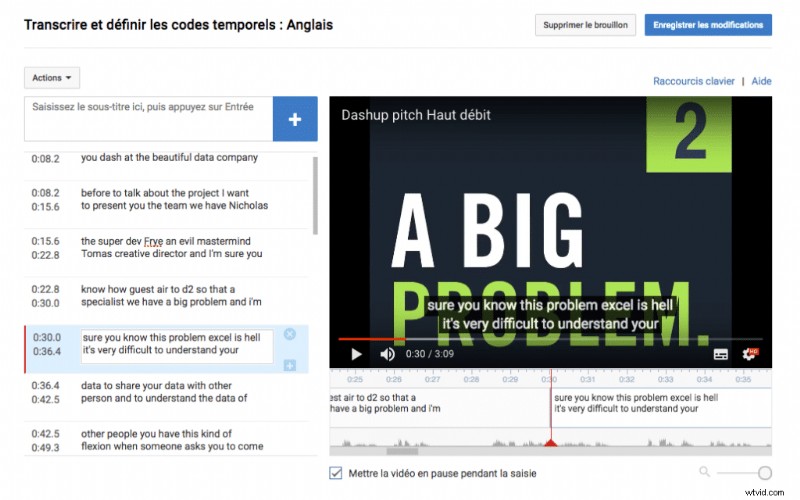
YouTube’s automatic subtitling platform is one of the most widely used. It has the advantage of being directly integrated into YouTube, but it is also free of charge. If subtitle quality is not a priority then it is more than enough. But if you want professional subtitles then in this case you might spend some time correcting the machine errors. The online interface is ergonomic but requires a lot of keyboard/mouse input in order to edit subtitles. We did the test with a timer and it takes as much or more time to correct the automatic subtitling of Youtube than to rewrite it entirely. But for those looking for a free solution, this is the best. For those who are interested, you have the step-by-step detail to use the Youtube automatic transcript in this article the best subtitling solutions on the market.
Please note that to use this solution you will have to upload your video to YouTube. But be aware that you can put it in private to prevent it from being visible to everyone.
Automatic Facebook subtitling
Facebook took a while to offer its online captioning solution. But inevitably in competition with YouTube, they had to come up with something. At the moment it’s not as good as YouTube. So if you only post on Facebook it can do the job but the other choices on this list are usually better.
Checksub:online automatic subtitling solution
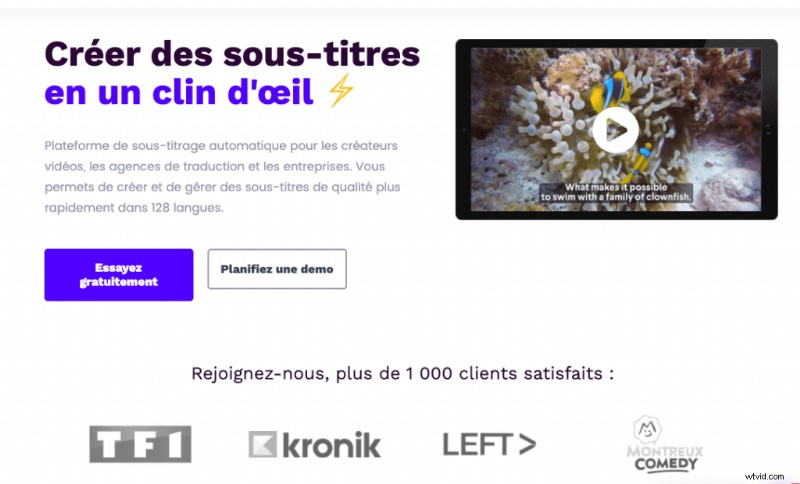
By 2017 I had tested all existing subtitling solutions. Automatic solutions did not allow me to create subtitles faster. In fact, I was spending more time correcting automatic subtitling rather than creating subtitles from scratch. So I came up with a solution that really saves time with technology. On April 1, 2020, we decided to make this solution available to everyone at www.checksub.com.
Over the last 2 years we have imagined and designed the dream solution for video professionals, communication agencies, translation agencies, e-learning trainers,… The objective is to use all available technologies to create quality subtitles.
The strength of the solution is based on 3 elements:
- the best speech recognition and machine translation APIs are used
- the online subtitle editor is powerful and very easy to use
- it is a collaborative platform for working with translators, clients or other partners
How Automatic Closed Captioning Works :
- Upload je video
- Indicate, the desired language(s)
- Reread automatic subtitles
- Export the video or subtitle source file
The Checksub platform allows you to create subtitles in 128 languages.
Kapwing
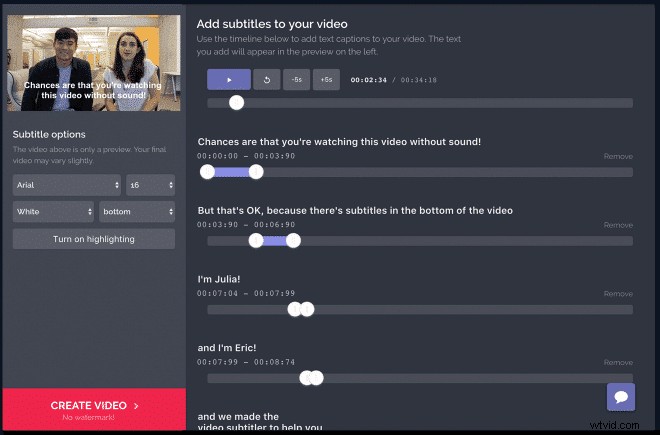
Kapwing is mainly made for videos for social networks. The automatic English transcript works very well. In other languages, the result is not so good. Kapwing’s automatic subtitling interface is very simple. This quickly becomes a limit if you want quality subtitling. We can also regret the absence of the audio spectrum to adjust the time codes precisely.
Rev :pour le sous-titrage anglais uniquement
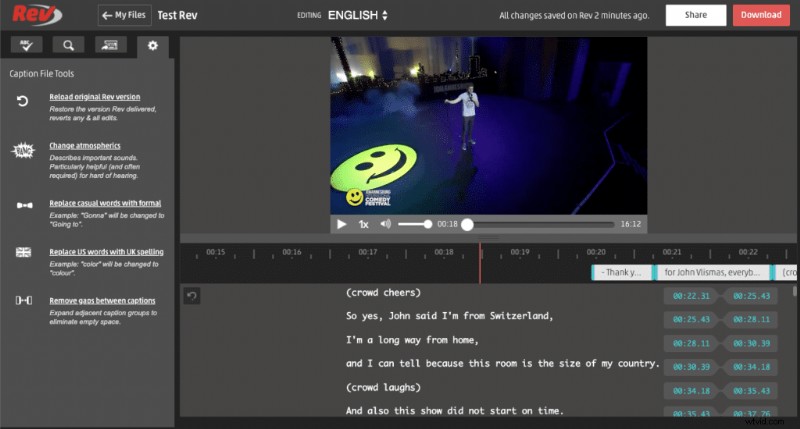
Rev is a transcription and captioning company that has become known for its manual (human) captioning service. For some time now it has been offering automatic subtitling. This service is only available for English videos. If your video is in another language you will not be able to use it. The result of the English transcription is of very good quality. Their online editor is very basic. Just like Kapwing, it is an interface that is meant to be quite simple and this is done at the expense of accuracy. This solution is therefore suitable if you have a project in English that is intended for social networks and the accuracy of the time codes is not a priority for you. In terms of price Rev is at the high end of the market.
Veed.io :for online video editing
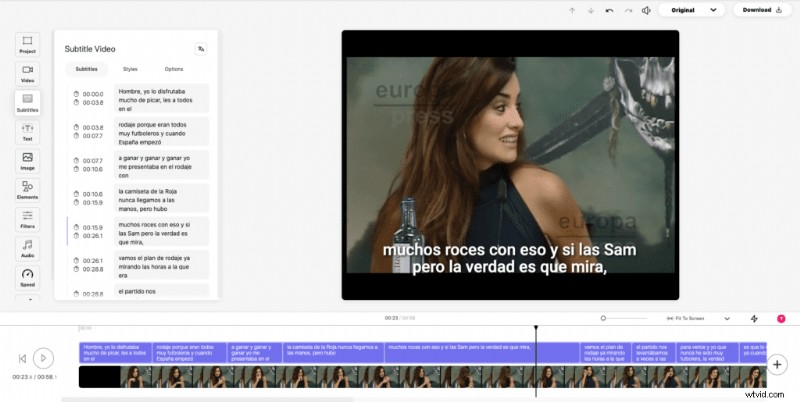
Veed.io is above all an online video editor. But they also offer an automatic subtitling function. The principle is similar to that of other platforms, you upload your video and you have a “subtitles” menu so that the platform automatically generates subtitles in the original language. They are the only ones besides Checksub to offer automatic subtitle translation. Veed.io is an ideal solution for those who need to modify the editing of their video. If you are looking for a solution to manage mainly your subtitle creations this is not the most suitable solution.
Authôt :For video transcriptions
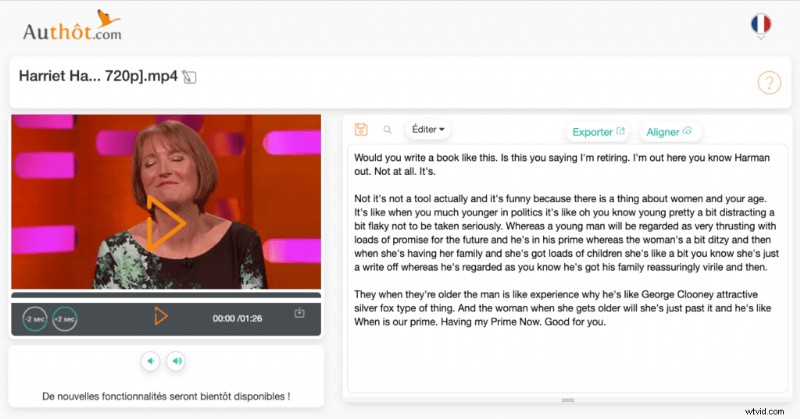
With Authôt it is possible to create a transcript of your video. But you should know that the tool is rather designed for the automatic transcription of audio documents. As soon as you open the interface, you will notice that the editor is less adapted to subtitling than its competitors. The subtitles are not displayed on the video, it is not possible to work on cutting the script into subtitles, and finally, it is impossible to modify the time codes.
Knowing that their rates are higher than other platforms, this solution does not seem to be suitable for the creation of subtitles. But this solution is interesting if you exceptionally have a subtitling project to do, you are used to using Authôt for your transcription and you already have credit. In this case, you don’t need to use another platform. But if your need for subtitling is becoming more and more important it would be a good idea to test other solutions.
4 – Tips to know :
Prepare your video file
Before starting to work on subtitling, it is essential that the editing be finalized. If after creating the subtitle you edit the video, the subtitle time codes may no longer match the video. This will force you to readjust all the subtitles or start from scratch. So even if you want to save time, wait until you have the final cut. If your changes do not affect the editing of the video at all (color, over-printing of text, …) it is not embarrassing and you can then start subtitling before the finalized version. But as soon as you modify the editing of the video you risk having staggered subtitles.
Optimize the download of your video
All the automatic subtitling solutions presented above require you to send the video to an external server for processing. If your video is too heavy and you don’t have the fiber, you may spend a lot of time uploading it to the server. The automatic subtitling platform will also take longer to prepare your project with a heavy video. So if you don’t need to generate an export from the platform by overlaying subtitles, it’s better to have a low definition version of your video to save time. In addition, if you have a slow Internet connection it will also save you time when loading the video on the platform. To compress your video you can use the Handbrake software available on this link:https://handbrake.fr/
In the case of a translation, correct the original subtitles.
As I explained earlier, machine translation will use subtitles in the original language. So the better the subtitles in the original language, the better the machine translation will be. So you have the choice to correct the original subtitles or spend more time on the foreign language subtitles. This is a tip that is especially valuable if you need to create subtitles in different foreign languages. Every change you make to the original subtitle saves you from having to redo it for each foreign language.
Recovering or exporting your video
Creating subtitles is good, using them is better. Depending on the use you want to make of the subtitles you will be able to export them in different formats. For example, if you want to add subtitles to a YouTube or Facebook video you will use the SRT format. If you want to customize the style of your subtitles it is necessary to generate a new export of the video by embedding the subtitles in the image. Checksub allows you to generate an export by embedding subtitles in the video. Alternatively, you can use a solution like Submerge to embed subtitles in a video. Here is a full tutorial to learn how to use Submerge to add subtitles to your video.
Add subtitles to a video already uploaded in Youtube, Facebook, Vimeo, Wistia,…
If the video you have just subtitled is already available on different platforms there is no need to upload your video again. If for example, you want to keep the views on YouTube you should avoid creating a new video that will make you start from scratch on all the statistics. In this case, it is best to upload the source file of the automatic subtitles, usually in SRT format, and then import it directly to the platform in question. This is an option that is available on almost all video hosting platforms that have a video player. It works with YouTube, Facebook, Vimeo, Wistia, and many others. The procedure, however, is specific to each form. We plan to do a tutorial to show how to do it. But for the moment the best is to look in the FAQ space of your hosting platform.
5 – To remember
As we have seen, there are many solutions, not all of which will necessarily save you time in subtitling. It is therefore important to choose the most suitable one. As a professional, the existing solutions did not suit me. That’s why I imagined and created Checksub. So if you are a video professional, a translation agency, a global company, … I invite you to test this solution because I imagined it for you.
Thank you for your attention and I hope this article will have helped you save a lot of time on the creation of your subtitles ⚡

Florian
